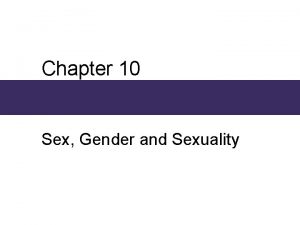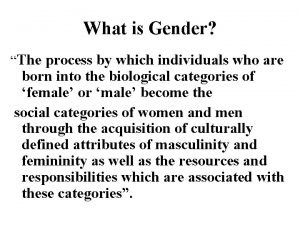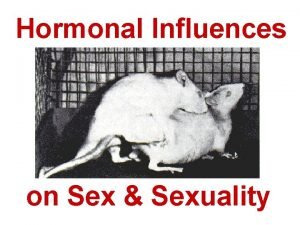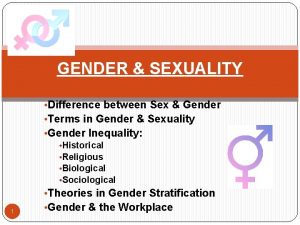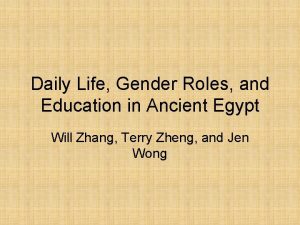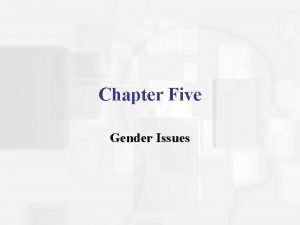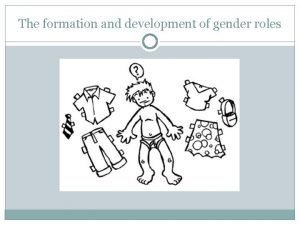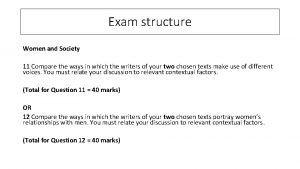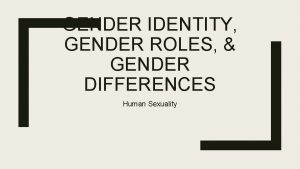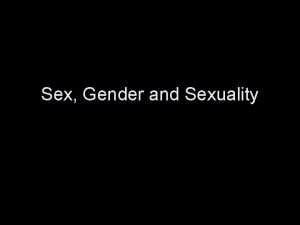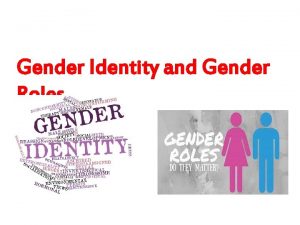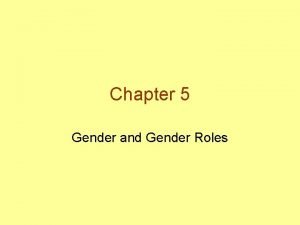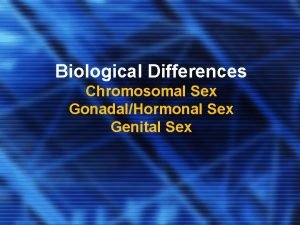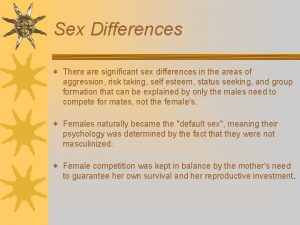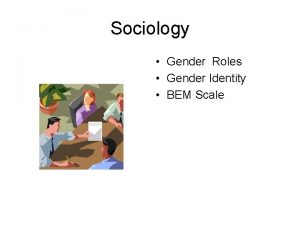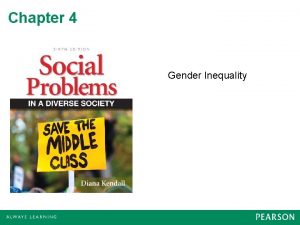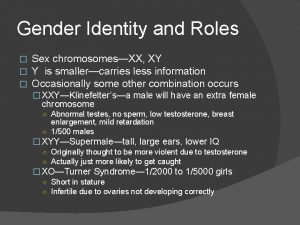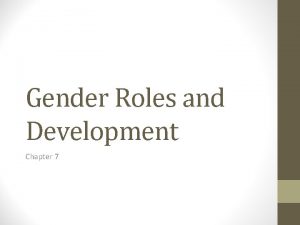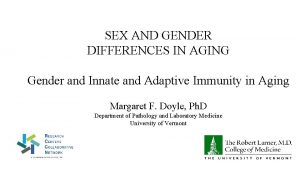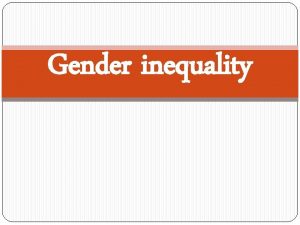GENDER IDENTITY GENDER ROLES AND SEX DIFFERENCES Chapter





































- Slides: 37

GENDER IDENTITY, GENDER ROLES, AND SEX DIFFERENCES Chapter 6

Learning Objectives • Prenatal Sexual Differentiation • Gender Identity • Gender Roles and Stereotypes • Gender Differences • Gender Typing • Psychological Androgony

Prenatal Sexual Differentiation The process by which males and females develop distinct reproductive anatomy Sperm fertilizes ovum resulting in zygote Each parent contributes 23 chromosomes 23 rd pair determine sex Females contribute X Males contribute X or Y • XX = Female • XY = Male

Prenatal Sexual Differentiation Embryo The stage of prenatal development that begins with implantation of a fertilized ovum in the uterus and concludes with development of the major organ systems at about two months after fertilization After seven weeks of prenatal development, the genetic code (XX or XY) results in changes in the gonads, genital ducts, and external genitalia. Ovaries begin to develop at 11 or 12 weeks.

Prenatal Sexual Differentiation Genetic Factors in Sexual Differentiation Genetic influences do exist SRY (sex-determining region on Y gene) Leads to the formation of the testes

Prenatal Sexual Differentiation The Role of Sex Hormones Androgens Male sex hormones Without androgens all infants would develop female external reproductive organs Presence results in the development of male external reproductive organs at about 8 weeks Small amounts found in female fetuses Absence in female fetuses prompts development of female sexual organs Female sex hormones are crucial in puberty, not for sex differentiation

Prenatal Sexual Differentiation Descent of the Testes and Ovaries Testes and ovaries develop from structures in the abdominal cavity The ovaries complete their descent after the prenatal period Testes descend via inguinal canal Cryptorchidism The condition defined by testes that fail to descend

Sex Chromosomal Abnormalities Klinefelter syndrome Caused by an extra X chromosome (XXY) in a male Fail to develop appropriate secondary sex characteristics May be mildly retarded Turner syndrome Caused by only one X chromosome (XO) in a female At risk for medical complications Spatial and math difficulties Infertility

Prenatal Sexual Differentiation Development of the internal sex organs from an undifferentiated stage at about five or six weeks after conception

Critical Thinking Critical thinkers do not oversimplify or overgeneralize. Consider this statement: In the absence of prenatal male sex hormones, we would all develop as females. Would we all develop as fertile females? In what way would we all develop as females?

Gender Identity Sex Assignment • Psychological awareness or sense of being male or female • Reflects anatomic sex at birth Children • First aware of anatomical sex by 18 months • Firmly acquire sense of gender identity at 36 months

Gender Identity Nature and Nurture • Gender identity is almost always consistent with one’s chromosomal sex • Does not certify that gender identity is biologically determined • People are usually reared as males or females in accordance with their sexual anatomy.

Gender Identity Hermaphrodite Intersexual • A person who possesses both ovarian and testicular tissue • Is extremely rare • A person who possesses gonads of one sex but external genitalia that are ambiguous or typical of the other sex The experiences of intersexual individuals have helped uncover the relative importance of nature and nurture.

Gender Identity • True hermaphroditism is rare • Congenital adrenal hyperplasia (CAH) is most common form of female intersexualism • Genetic female has female internal Intersexualism sexual structures but masculinized external genitals • Due to exposure to excess levels of androgens • Girls with CAH exhibit more interest in masculine-typed behaviors • Results may support a hormonal contribution to gender identity

Gender Identity • Androgen-insensitivity syndrome • Genetic male is prenatally insensitive to Intersexualism androgens such that his genitals are not normally masculinized • Genetic female with partial or complete insensitivity develops typical external organs, but internal organs don’t develop or function normally

Gender Identity • Dominican Republic syndrome • A genetic enzyme disorder prevents Intersexualism testosterone from masculinizing the external genitalia • Raised as females • At puberty, testosterone levels become normal • Voices deepened, musculature filled out, “clitorises” expanded into penises • Most shift to male gender identity

Gender Identity Research suggests that gender identity is influenced by complex interaction of biological and psychosocial factors • Dominican Republic boys suggest importance of biology to gender • Studies of girls with partial or complete androgen insensitivity suggest that two X sex chromosomes are not essential to develop feminine-typed behavior

Gender Identity Transgenderism • Individual strongly desires to be of the other sex and live as the other sex • Many undergo hormone treatments and surgery so body matches sense of self The term transsexualism was used previously

Gender Identity Sex Reassignment • Health professionals conduct evaluations • Hormone treatments • Live openly as member of the other sex for extended period of time • Surgery • Most postoperative reports are positive

Gender Roles and Stereotypes Stereotype Gender roles • A fixed, conventional idea about a group of people • Often a distorted generalization • Complex clusters of expectations for how males and females should behave

Critical Thinking Why would a researcher bother to study whether traditional gender-role stereotypes are found around the world?

Gender Roles and Stereotypes Sexism • The prejudgment that because of her or his sex, a person will possess certain negative traits • Psychologically damaging • Can influence career choice • Education can change traditional sexist attitudes

Gender Roles and Stereotypes Gender Roles and Sexual Behavior • Men as initiators, women as gatekeepers • Men make the choices regarding sexual positions and techniques • Men as overaroused, women as underaroused • Men more interested in sex than women

Gender Differences in Cognitive Abilities No overall differences in intellectual functioning Some gender differences appear for certain cognitive abilities Females better at verbal tasks These are in group differences Variability is larger within the sexes than between the sexes Differences may largely reflect environmental influences and cultural expectations No difference in math abilities despite stereotype Males better at visual/spatial tasks

Gender Differences in Personality Females are more extraverted, anxious, trusting, and nurturing Males are more assertive, toughminded, and have higher self-esteem Differences tend to be small Relative lower selfesteem for girls Parents prefer boys Unlevelled playing field in society

Sex Differences in Social Behavior Communication Styles Males dominate discussions Females express their feelings more than males do Sexuality Men show more interest in sex Women combine sex with romance Aggressiveness Males engage in more overt aggression compared to females Willingness to seek health care Men let symptoms go Women live an average of seven years longer than men do

Gender Typing The process by which children acquire behavior that is deemed appropriate to their sex

Gender Typing Biological Perspectives • Hormones • Most studies find no relationships • One study showed fetal testosterone level linked to sex-typed behavior in infants

Gender Typing Biological Perspectives • Evolutionary perspective • Genes that contribute to survival are passed on • Genetic heritage influences social and sexual behavior • Traditional roles are passed on through genes • Controversial perspective

Critical Thinkin g Why do you think many feminists and queer theorists argue that evolutionary theory is little more than a sophisticated excuse for maintaining the status quo in the centers of power in society?

Gender Typing Biological Perspectives • Prenatal brain organization • May explain men’s overall superiority at visual/spatial tasks and women’s overall superiority at verbal tasks • Prenatal sex hormones may create a greater or reduced tendency to act physically aggressive

Gender Typing Psychological Perspectives • Psychoanalytic Theory • Gender typing occurs through identification with the same-sex parent • A resolution to the Oedipus complex (or Electra complex in girls)

Gender Typing Psychological Perspectives • Social-cognitive theory • Gender typing occurs through the processes of observational learning, identification, and socialization • Guiding people into socially acceptable behavior patterns by using information, rewards, and punishments

Gender Typing Psychological Perspectives • Cognitive-developmental theory • Gender typing occurs through cognitive development • Schema • A concept or way of interpreting experience or processing information • Gender stability • Concept that people retain their genders for a lifetime • Gender constancy • Concept that people’s genders do not change, even if they alter their dress or behavior

Gender Typing Psychological Perspectives • Gender schema theory • Gender schema • Cluster of mental representations about male and female physical qualities, behaviors, and personality traits • Once learned, children evaluate themselves in terms that are appropriate to their sex • Higher self-esteem is associated with selfconcepts that are congruent with the prominent gender schema of one’s culture • A gender schema can lead to gender-appropriate behaviors and affects mental processes, e. g. , memory

Psychological Androgyny A state characterized by possession of both stereotypical masculine traits and stereotypical feminine traits • May be more able to summon wide range of traits to act on the demands of the situation • Associated with psychological well-being and higher self-esteem

Critical Thinking Explain why feminists have criticized the concept of psychological androgyny.
 Sex sex sex
Sex sex sex Snv sex
Snv sex Xxtesticles
Xxtesticles Sex sex sex
Sex sex sex Secondary sexual characters
Secondary sexual characters Development of gender roles
Development of gender roles Chapter 10 sex gender and sexuality
Chapter 10 sex gender and sexuality X linked punnett square
X linked punnett square Sex rat
Sex rat Sex determination and sex linkage
Sex determination and sex linkage Sex and gender difference
Sex and gender difference The difference between sex and gender
The difference between sex and gender Androgen insensitivity syndrome
Androgen insensitivity syndrome What is talcott parsons structural functionalism
What is talcott parsons structural functionalism Difference between sex and gender
Difference between sex and gender Once a sex offender always a sex offender
Once a sex offender always a sex offender Gender roles in snow white
Gender roles in snow white Integration of gender roles in school and curriculum
Integration of gender roles in school and curriculum Strategic gender needs and practical gender needs
Strategic gender needs and practical gender needs Sex vs gender essay video
Sex vs gender essay video Is there any bias in gender roles based on the excerpt
Is there any bias in gender roles based on the excerpt Ancient gender roles
Ancient gender roles Contemporary gender roles
Contemporary gender roles Are gender roles a social construct
Are gender roles a social construct Gender in casablanca
Gender in casablanca What does the bible say about gender roles
What does the bible say about gender roles Gender roles theory
Gender roles theory Indus valley gender roles
Indus valley gender roles Qin dynasty gender roles
Qin dynasty gender roles David reimer story
David reimer story Motifs in a thousand splendid suns
Motifs in a thousand splendid suns Sexual orientation gender identity
Sexual orientation gender identity Gender identity
Gender identity Gender identity tagalog
Gender identity tagalog Identity project ideas
Identity project ideas Chapter 11 gender age and health review worksheet answers
Chapter 11 gender age and health review worksheet answers Chapter 7 section 1 regional economies create differences
Chapter 7 section 1 regional economies create differences Parents and offspring
Parents and offspring






